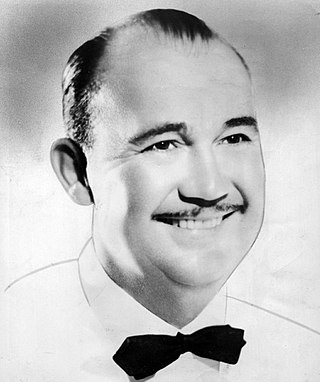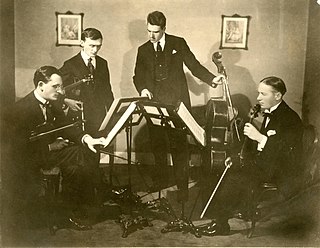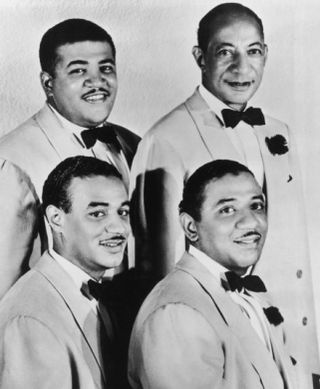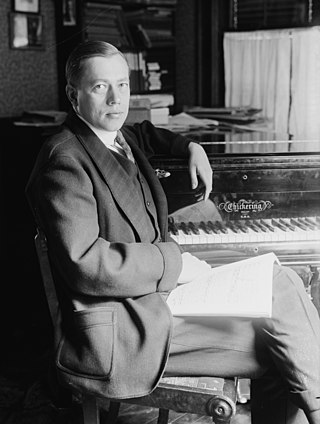Related Research Articles

A big band or jazz orchestra is a type of musical ensemble of jazz music that usually consists of ten or more musicians with four sections: saxophones, trumpets, trombones, and a rhythm section. Big bands originated during the early 1910s and dominated jazz in the early 1940s when swing was most popular. The term "big band" is also used to describe a genre of music, although this was not the only style of music played by big bands.

Paul Samuel Whiteman was an American bandleader, composer, orchestral director, and violinist.

Andrew Dewey Kirk was an American jazz bandleader and saxophonist who led the Twelve Clouds of Joy, a band popular during the swing era.

Joseph Matthews "Wingy" Manone was an American jazz trumpeter, composer, singer, and bandleader. His recordings included "Tar Paper Stomp", "Nickel in the Slot", "Downright Disgusted Blues", "There'll Come a Time ", and "Tailgate Ramble".

Estelle Liebling was an American soprano, composer, arranger, music editor, and celebrated voice teacher and vocal coach.

Max Lorenz was a German heldentenor famous for Wagnerian roles.

The Revelers were an American quintet popular in the late 1920s and early 1930s. The Revelers' recordings of "Dinah", "Old Man River", "Valencia", "Baby Face", "Blue Room", "The Birth of the Blues", "When Yuba Plays the Rhumba on the Tuba", and many more, became popular in the United States and then Europe in the late 1920s. They also produced the first known recording of "I've Been Working on the Railroad" in 1923. In August 1929, they appeared in the Netherlands with Richard Tauber at the Kurhaus, Scheveningen and the Concertgebouw, Amsterdam.

The Rhythm Boys were an American male singing trio consisting of Bing Crosby, Harry Barris and Al Rinker. Crosby and Rinker began performing together in 1925 and were recruited by Paul Whiteman in late 1926. Pianist/singer/songwriter Barris joined the team in 1927. They made a number of recordings with the Whiteman Orchestra and released singles in their own right with Barris on piano. They appeared with the Whiteman orchestra in the film King of Jazz, in which they sang "Mississippi Mud", "So the Bluebirds and the Blackbirds Got Together", "A Bench in the Park", and "Happy Feet". They are best remembered for launching Crosby's solo career, one that would make him the greatest song charting act in history and one of the most influential entertainers of the twentieth century.

Harry Barris was an American popular singer and songwriter. He was one of the earliest singers to use "scat singing" in recordings. Barris, one of Paul Whiteman's Rhythm Boys, along with Bing Crosby and Al Rinker, scatted on several songs, including "Mississippi Mud," which Barris wrote in 1927.

Gus Arnheim was an American pianist and an early popular band leader. He is noted for writing several songs with his first hit being "I Cried for You" from 1923. He was most popular in the 1920s and 1930s. He also had a few small acting roles.

"Nobody's Sweetheart", also known as "Nobody's Sweetheart Now" and "You're Nobody's Sweetheart Now", is a popular song, written in 1924, with music by Billy Meyers and Elmer Schoebel, and lyrics by Gus Kahn and Ernie Erdman. The song is a jazz and pop standard.

The London String Quartet was a string quartet founded in London in 1908 which remained one of the leading English chamber groups into the 1930s, and made several well-known recordings.

"Mississippi Mud" is a 1927 song written by Harry Barris, first sung by Bing Crosby as a member of Paul Whiteman's Rhythm Boys. Its musical composition entered the public domain on January 1, 2023.
Joseph Anthony "Fud" Livingston was an American jazz clarinetist, saxophonist, arranger, and composer.

Franklyn Baur was a popular tenor vocal recording artist.

The Mills Brothers, sometimes billed The Four Mills Brothers and originally known as Four Boys and a Guitar, were an American jazz and traditional pop vocal quartet who made more than 2,000 recordings that sold more than 50 million copies and garnered at least three dozen gold records.
The Cappy Barra Harmonica Band was an American harmonica ensemble — originally a trio, then a quartet, then two groups — that played big band arrangements. Cappy Barra flourished from 1935 to 1945.

Reinald Werrenrath was an American baritone opera singer, who also recorded popular songs and appeared regularly on radio in the early decades of the twentieth century. Werrenrath commonly used the pseudonym Edward Hamilton.
The Eton Boys, or The Four Eton Boys, were an American all-male musical quartet from the St. Louis, Missouri area, whose members were Art Gentry, lead; Earl Smith, tenor; Charles Day, baritone; and Jack Day, bass. "Incidentally, The Eton Boys never went to Eton College," write authors Scott MacGillivray and Ted Okuda; "the group's name is simply a musical reference ."
Josepha Chekova, sometimes given as Josefa Chekova and also known by her married name Josepha Domansky, was a Czech-American soprano. She began her career in vaudeville as early as 1924, and was a contracted singer with WRNY radio in 1926-1927. After appearing in a musical revue in Chicago, she won a vocal competition in 1927 which provided her with a scholarship to train as an opera singer at the Bel Canto Studio, Inc. of New York. She later studied singing further in New York City with Estelle Liebling. She made her opera debut at the Prague State Opera prior to becoming a leading soprano with the New York Opera Company in 1933. She was a leading soprano at Radio City Music Hall in 1930s, and toured with the San Carlo Opera Company in 1935-1936. She worked regularly with the Steel Pier Opera Company in Atlantic City from the mid 1930s into the early 1940s, and also appeared as a guest artist with opera companies in Washington D.C., Cincinnati, and Chicago. From 1940-1942 she toured with Armand Bagarozy's Columbia Opera Company, and in 1948 she gave a concert tour of Czechoslovakia.
References
- 1 2 "It Could Only Happen on Radio". What's on the Air. 1: 35. 1929.
- 1 2 3 Rayno, Don (2003). Paul Whiteman: Pioneer in American Music, 1930-1967. Scarecrow Press. p. 368. ISBN 9780810883222.
- ↑ "The Rondoliers". Discography of American Historical Recordings . University of California, Santa Barbara . Retrieved July 10, 2024.
- 1 2 Cantor, Mark (2023). "1003 That's A Lot of Schicklgruber". The Soundies: A History and Catalog of Jukebox Film Shorts of the 1940s. McFarland & Company. ISBN 9781476646428.
- ↑ Dean Fowler, Alandra (1994). Estelle Liebling: An exploration of her pedagogical principles as an extension and elaboration of the Marchesi method, including a survey of her music and editing for coloratura soprano and other voices (PhD). University of Arizona.